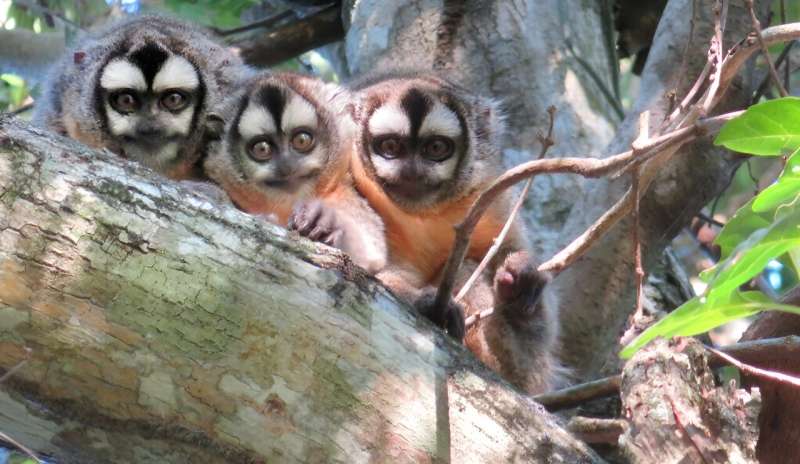This article has been reviewed according to Science X's editorial process and policies. Editors have highlighted the following attributes while ensuring the content's credibility:
fact-checked
peer-reviewed publication
trusted source
proofread
Moving out: Mix of factors prompt owl monkeys to leave their parents

There comes a point in the lives of young owl monkeys when they leave their parents and strike out on their own to find a mate.
In a new study of a wild population of Azara's owl monkeys in northern Argentina, Yale researchers reveal that a combination of social and ecological factors influences when these tree-dwelling monkeys peel away from their parents and siblings.
According to their findings—which were based on 25 years of genetic and demographic data for several generations of owl monkeys, covering more than 330 individuals—none of the individuals, regardless of their sex, reproduced in the same group where they were born. In all cases, the researchers found, the animals either departed from their natal group or died before reproducing.
The researchers also found that particular factors—such as the arrival of a stepparent, or seasonal changes in climate and the availability of food—affected the age and timing when individual owl monkeys left the group.
"Owl monkeys are pair-living, serially monogamous, and both parents directly care for their offspring, which makes them very unusual among mammals," said the lead author Margaret K. Corley, an associate research scientist in the Department of Ecology and Evolutionary Biology in Yale's Faculty of Arts and Sciences (FAS). "Better understanding what influences owl monkeys' decisions to leave their natal groups helps us to evaluate the evolution and functioning of their unique and interesting social structure."
The study, published on Aug. 7 in the journal Royal Society Open Science, was coauthored by Eduardo Fernandez-Duque, professor of anthropology in FAS. In 1996, Fernandez-Duque founded the Owl Monkey Project, a multi-disciplinary research site in the Argentinian Chaco. Research conducted at the project's field site—one of the few places where owl monkeys are studied in the wild—provided the life history and genetic data used in the analysis.
For the new study, the researchers evaluated two prominent hypotheses on the evolution of animal dispersal. One, known as the inbreeding avoidance hypothesis, posits that dispersal is driven by the risks of individuals mating with close kin if they remain in the natal group. The other, the competition avoidance hypothesis, suggests that owl monkeys leave their natal groups to avoid competing over potential mates and resources with other members of the group.
If avoiding inbreeding drives dispersal, then owl monkeys would consistently disperse before or near sexual maturity, the researchers said. However, the study found that while some individuals dispersed around the time they reached sexual maturity, others remained with their groups up to two years after they were sexually mature. The finding demonstrates that inbreeding avoidance does not fully explain the timing or age of dispersal, but it does help to explain why all the monkeys dispersed before reproducing, the researchers explained.
The study also revealed that the replacement of a parent by a genetically unrelated adult—a stepparent—affects the age at which individuals disperse. Offspring delayed dispersal if their stepparent is of the opposite sex, the researchers found.
"Older offspring will stick around longer when their stepparent is of the opposite sex and represents a potential mate. The situation puts them in competition with their genetic parent of the same sex," Corley said. "If mating competition with kin were driving dispersal, we would expect to see offspring disperse sooner, rather than later, when their opposite-sex parent is replaced."
The study found that owl monkey dispersals are highly seasonal; most occur in the spring when food is abundant and temperatures are relatively warm, indicating that individuals look to begin solitary ranging when conditions are mild and there is plenty to eat. The monkeys were less likely to disperse during the winter when food is less available, suggesting that resource competition within groups does not drive the timing of dispersal, the researchers concluded.
"Owl monkeys are unusual in a lot of ways, and we have a lot left to learn about their social structure and behavior," Corley said.
More information: Margaret Corley et al, Inbreeding avoidance, competition and natal dispersal in a pair-living, genetically monogamous mammal, Azara's owl monkey ( Aotus azarae ), Royal Society Open Science (2024). DOI: 10.1098/rsos.240379
Journal information: Royal Society Open Science
Provided by Yale University




















